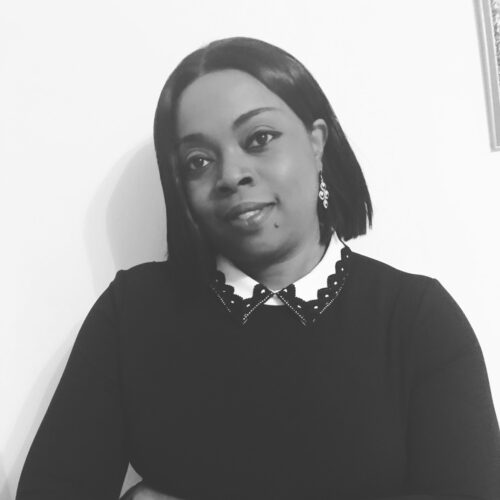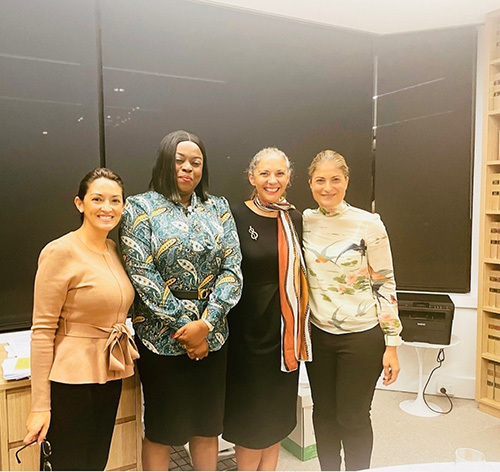
The International Women’s Day (IWD) celebrates the social, economic, cultural and political achievements of women globally. The New South Wales Bar Association's Diversity and Equality Committee (DEC), chaired by Kate Eastman SC, organised a panel discussion to celebrate the IWD. The panellists were the Honourable Justice Dina Yehia SC and UK barrister, Sally Penni. Melanie Cairns and Uche Okereke-Fisher were moderators of the panel.
The campaign theme of this year’s IWD for the New South Wales Bar, was ‘Break the Bias’. The theme was aimed at raising awareness of the prejudice that black women (and men) face in court and at the Bar.
As the keynote speaker, the Honourable Justice Dina Yehia SC shared with the audience her experience as judge, senior counsel, chair of the Diverse Women in Law (DWL) and as co-founder of the Walama List. Her Honour delivered a truly inspiring and thought-provoking speech which shed light on the implicit bias faced by women from diverse backgrounds as law graduates entering the profession, as practitioners in the profession and the over-representation of Indigenous women in the Australian criminal justice system.
Ms Penni provided insight into the UK Bar and shared with the audience initiatives adopted in that jurisdiction to combat prejudice and promote diversity. Ms Penni’s speech was intentional, forceful and with purpose. She pointed out that in the UK, they look to the US for guidance and progress. Also, she noted that President Biden had just appointed the first black woman, Judge Ketanji Brown Jackson, to the United States Supreme Court. In her view, the appointment was significant because ‘if you cannot see it then you cannot be it’.
Acknowledgement of progress
The Honourable Justice Dina Yehia SC commenced by applauding the work of the DEC in developing and implementing policies designed to attract and retain barristers from diverse backgrounds. Her Honour acknowledged the progress made by women in the law over the last two or three decades, evident in the recent appointments of Justice Lucy McCallum as the chief justice of the ACT, the Honourable Justice Julie Ward as president of the NSW Court of Appeal, Gabrielle Bashir SC as senior vice-president of the New South Wales Bar and Anna Mitchelmore SC as its junior vice-president.
Her Honour graciously extended her gratitude to ‘male allies’, a cohort of men in the profession who ‘understand the importance of not just mentoring women, but sponsoring them and ensuring that they get briefed not just as junior counsel but as lead counsel, and by promoting them into positions of leadership’. Ms Penni agreed that it was critical to have allies. She noted that most of the demonstrators who marched, in the aftermath of George Floyd’s murder, were from non-minority backgrounds.
Despite the acknowledgement of progress, her Honour unequivocally stated, ‘The reality is that the power in the legal profession still lies overwhelmingly with men from a certain background of privilege’. She opined that there has been progress but there is a long way to go.

Implicit or unconscious bias
Her Honour stated that there is a degree of implicit bias or unconscious bias in recruiting and briefing practises. She highlighted the plight of women graduates from diverse backgrounds who apply for a job, conscious that they are the only black woman in the pool of applicants, knowing that no one in the interviewing panel will be wearing a hijab and worried that their surname immediately identifies them as different. These women, she said, want to be reassured that the fact that they are different is not an impediment.
To demonstrate unconscious bias, her Honour recalled the experience of an Indigenous solicitor who attended at a Local Court and took a seat at the Bar table, ready to mention her case. As she stood up to mention her matter, the magistrate asked her to sit in the public section of the court until her solicitor arrives. The Indigenous solicitor advised the magistrate that she was in fact, the solicitor. Ms Penni observed that the issue of black practitioners being addressed as defendants in magistrate courts is not unique to Australia. She cited the well-publicised case of Ms Alexandra Wilson1 a black UK barrister and Oxford University graduate, who was mistaken for a defendant in the Magistrate Court, three times on the same day. Ms Penni (of Black African origin) added that she had also been similarly queried in a criminal court even though she was clad in her wig and gown.
First Nations women in the criminal justice system
Furthermore, her Honour discussed the bias faced by women of colour, who appear in courts as offenders. Her Honour shared an excerpt from the Uluru Statement from the Heart, with First Nations people declaring that that they are the most incarcerated people on the planet, and they are not an innately criminal people. Her Honour shared statistics to demonstrate the plight of First Nations women as offenders:
• Indigenous women are over-represented in the sentenced population with a 49 per cent increase since 2013, relative to a six per cent increase among non-indigenous women.
• 32 per cent of women in custody are Aboriginal and Torres Strait Islander. Eighty per cent of these women in custody are mothers.
Her Honour queried whether there was implicit bias in our sentence practices, akin to that exhibited by the well-meaning magistrate, in mistaking the Indigenous solicitor for a defendant in court.
The case for diversity
Outlining the need for diversity in our profession, her Honour stated, ‘Diversity on the Bench is fundamentally important in continuing community confidence in the judiciary’. Her Honour further stated that lawyers from diverse backgrounds should be mentored and supported to attain high ranks in the profession, in order to ensure that the judiciary reflects the society from which it is drawn. She cited the remarks of the former chief justice of the New South Wales Supreme Court, the Honourable Tom Bathurst AC, in his swearing out speech, where he isolated ‘diversity in the court’ as one the issues confronting the profession. The case for cultural and gender diversity was reiterated in Ms Penni’s speech and she argued that the issue of gender or cultural diversity would not arise if women were allocated equal amounts of work as their male colleagues.
Her Honour encouraged the audience to see diversity in broader terms, beyond gender diversity and recognise the significance of intersectionality. In her speech, Ms Penni cautioned against possible competition among different diversity traits.

Dearth of statistics in Australia
The Honourable Justice Dina Yehia SC is surprised by the lack of detailed statistics measuring the number of women practitioners or judges from diverse backgrounds and the absence of study disclosing the percentage of women senior counsels from diverse backgrounds. Her Honour asserted that the absence of such detailed statistics in relation to women from diverse backgrounds in the law deprives the profession of evidence required to support advocacy for change. Nevertheless, her Honour cited the following statistics
• 60 per cent of law graduates in NSW are women and 23 per cent of barristers are women.
• 11 per cent of senior counsel are women.
• In 2020, only 0.7 per cent of all female solicitors in Australia were Indigenous.
• Of the 144 magistrates in NSW, only one is Indigenous.
• In New South Wales, 40 per cent of District Court judges are women, but there has been one Indigenous judge appointed to the court.
• Eight per cent of partners and non-partner lawyers were from a diverse background2 .
UK statistics
Ms Penni observed that while the UK was not leading the way in breaking the bias, it was certainly making progress. She cited a number of reports3 to support her stance. The UK statistics show: 4
• Women are well represented in the solicitor ranks but are less so among the more experienced and more senior members of the legal profession.
• Women constitute 39 per cent of barristers, 52 per cent of solicitors and 76 per cent of chartered legal executives. Among professionals with 15 or more years of legal experience, 33 per cent of barristers, 44 per cent of solicitors and 73 per cent of chartered legal executives were women.
• Representation of gender-ethnicity intersection groups vary across the legal professions. In all three professions, representation of White men was higher in professionals with more experience and in higher seniority positions.
• As of 1 April 2021, White men constituted the highest proportion of barristers (53 per cent), followed by White women (32 per cent), Black, Asian and minority ethnic men (eight per cent) and Black, Asian and minority ethnic women (seven per cent). White men and White women constituted the joint highest proportion of solicitors (41 per cent), followed by Black, Asian and minority ethnic women (10 per cent), then men (eight per cent). White women constituted two thirds (67 per cent) of chartered legal executives.
• More than half of the judiciary are White men and a third are White women. Black, Asian and minority ethnic men and women each account for five per cent of judges. As of 1 April 2021, Black, Asian and minority ethnic men and women each accounted for five per cent of judges in post. White women accounted for 35 per cent and White men accounted for the remaining 55 per cent. Representation of these groups differed between courts and tribunals, with a higher proportion of women from both White and Black, Asian and minority ethnic backgrounds among tribunal judges. Within the senior courts, White men constituted a larger proportion of posts.
• Only one per cent of judges in courts and tribunals were Black, a figure that is unchanged since 2014.5
The UK report, Race at the Bar6 revealed the following:
• Access to the Bar, career progression and retention are all influenced by ethnicity and structural discrimination.
• At all levels, White male barristers earn the highest fee income, women earn less than men, and Black women earn the least.
• In England and Wales there are five Black or Black British female QCs, 17 Black or Black British male QCs, 17 female QCs who are Asian or Asian British and 60 male Asian or Asian British QCs.
• Black and Asian women at the Bar are four times more likely to experience bullying and harassment at work than White men.
Solutions and initiatives
The panellists proffered a raft of solutions including:
1. Mentoring and networking programs for women, particularly for women from diverse backgrounds.
2. Sponsorship, in the sense of actually giving women the work, briefing women not just as junior counsel but as lead counsel. There must be sponsorship of women, in particular women from diverse backgrounds.
3. The profession must maintain statistics about women from diverse backgrounds in the profession.
4. Change in culture, shift in mindset: This is the most fundamental requirement as it touches on implicit or unconscious bias.
5. Tackling bias with blind screening, blind interviewing, blind hiring may address implicit bias in some areas of the profession.
6. Education: Those in positions of power and those responsible for recruiting and briefing need to be educated on cultural diversity and implicit bias. The Bar Standard requires UK Bar Council members to undertake compulsory diversity training.
7. Bar Leadership Program: The UK Bar runs a Bar Leadership Program that offers members opportunities for leadership at the Bar, outside taking silk. The program attracts practitioners from diverse backgrounds.
8. Badge: To combat racism, bullying and harassment in court, some practitioners in the UK have taken to wearing a badge that reads ‘I am wearing this badge because I don’t support belittling, harassment and embarrassment in court’.
9. Accountability: Those responsible for recruiting and briefing need to change their practices to be inclusive of women and in particular, women from diverse backgrounds. Information about hiring and briefing practices need to be publicly available. Individuals, organisations and institutions should be accountable for their practices. BN

ENDNOTES
1 www.bbc.com/news/uk-england-essex-54694167
2 2019 study conducted by Baker & Makenzie, Herbert Smith Freehills, Mallesons, Clayton Utz and Ashurst.
3 See endnotes 4 and 6.
4 https://www.gov.uk/government/statistics/diversity-of-the-judiciary- 2021-statistics/diversity-of-the-judiciary-2021-statistics-report. The terms ‘Black/Black British’ and ‘Asian/Asian British’ are self-identifying designations specifically drawn from the classification of ethnic groups in the UK 2021 census data.
5 https://www.judiciary.uk/announcements/judicial-diversity-and- inclusion-first-annual-update/
6 https://www.barcouncil.org.uk/uploads/assets/d821c952-ec38-41b2- a41ebeea362b28e5/Race-at-the-Bar-Report-2021.pdf
